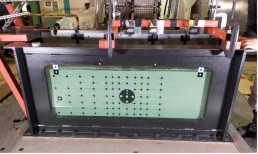Introduction and Methodology
Liquefaction hazard potential could cause serious damage, one of them is uplift of underground structures. In the other side, it is known that liquefaction also could occurred in soil containing fines particle. The study will compare the influence of non-plastic fines content in ground to the total uplift and initiation of uplift while in addition to the initiation of liquefaction itself.
1-G model tests are utilized in ground with composition of silica sand #7 mixed with different composition of non-plastic fines, DL-Clay, from 0% up to 20%. Ground with relative density of 50% were made in order to reproduce the liquefied ground while black targets were attached on the glass side of the experimental box in order to observe the ground and pipes motion during the shaking alongside with several pore water pressure and accelerometer sensors at different depths.
Test Results
Initial results shown that ground containing 0% fines content (100% clean sand) has highest total uplift value, but the uplift started relatively later contrary with ground containing 10% and 20% fines content which have lowest total uplift value, but the uplift started relatively earlier.



